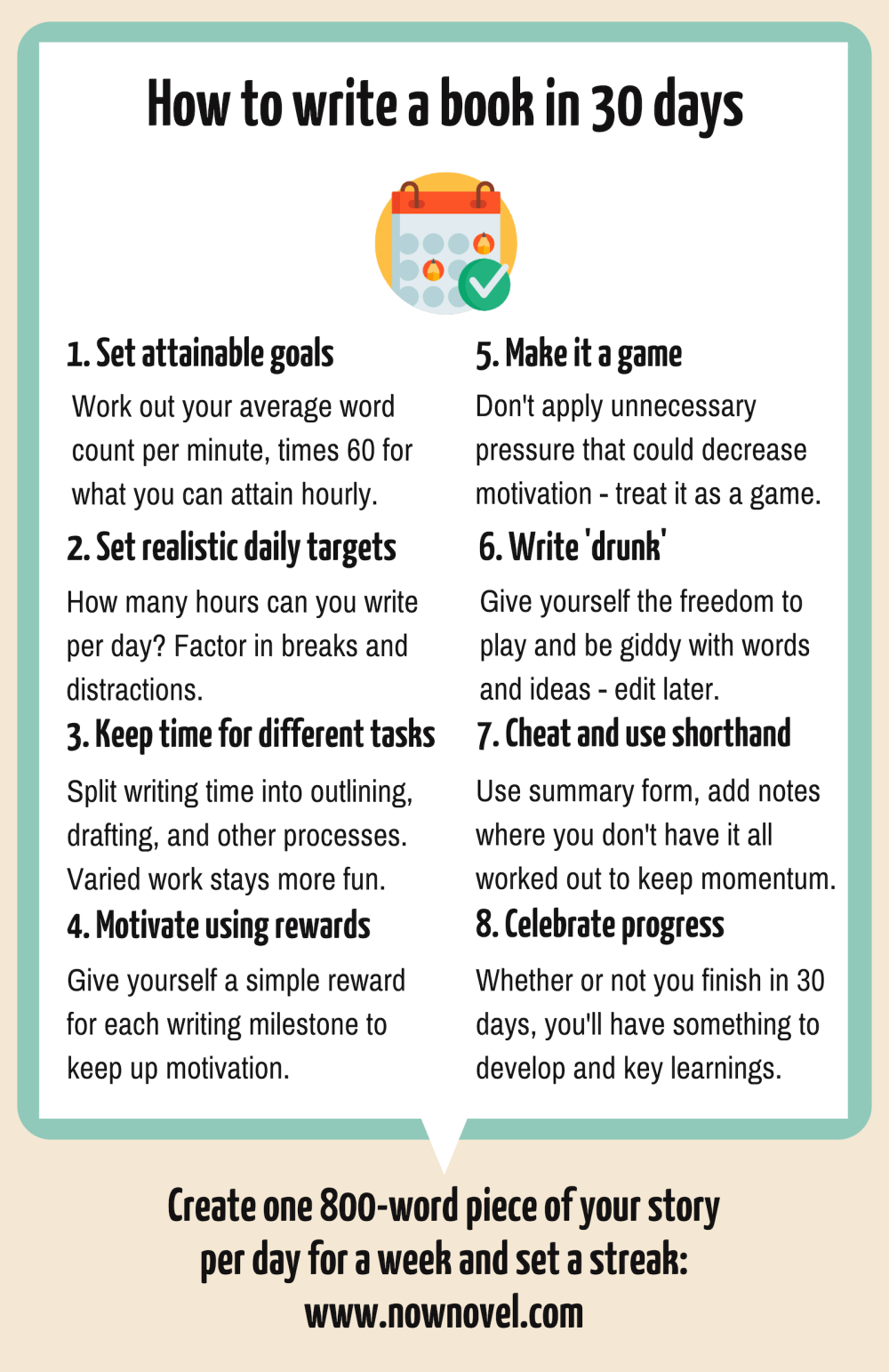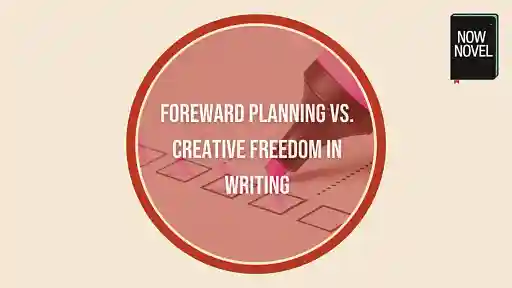Annual writing sprints like NaNoWriMo have many experienced and new authors alike testing their limits. Writing a book - a carefully, beautifully constructed book - does take time. Usually, much longer than 30 days. Yet trying this exercise is useful for building discipline, focus and just getting the first draft done. Here are 8 tips to help:
1: Set attainable goals
When someone asks 'how do I write a book in x days?' Writers' reactions are sometimes discouraging. 'Never write a book with a deadline as small as 30 days!' Says one Quora user. Reasons you shouldn't attempt to write a book in such a small time-frame include:
- Being limited by time constraints could result in low quality writing
- Producing a first draft may be possible within 30 days but you also need time to revise and edit
- Burnout is possible if you don't take sufficient breaks
These are all valid concerns. To work out it you can finish your novel in 30 days:
- Calculate how many words you write per minute: Use a free words-per-minute checker such as Typing Speed Test.
- Keeping in mind that you will also need to pause from time to time to think what happens next, halve your word count per minute. If you can type as fast as 60 wpm, take 30 as your base rate.
- Work out how many words you write per hour: If you can write 30 per minute, you can write approximately 1800 words per hour (assuming you don't stop to edit or rest). Factor in resting time for a more conservative estimate (e.g. 1000 words).
- Work out how many hours you will have to write each day on average over the next 30. If you write 1000 words of draft per hour on a good day, an 80, 000 word novel should take 80 hours of writing to complete.
- Eighty hours of writing over 30 days would mean spending an average of 2.6 hours of writing per day. This is a lot when you have other commitments.
- Based on the amount of time you have available to write each day, adjust the length of your first draft until you have a word count you can achieve. You can always expand during subsequent drafts. Or write your first draft as a brief, novella version.
If this seems like an impossible task, give yourself more days. Or write some scenes in summary form. You can add connective tissue between plot events (such as scene transitions) later.
2: Set a realistic daily word count target
Many authors find as they learn how to write a book that realistic, attainable targets help immensely.
You might say to yourself 'I can write for an hour each day, easily.' The truth is that surprises, last minute obligations and life in general can hijack your writing time. For every hour of free time you have, bank on getting half an hour of that to write.
Start thinking about how you can make your word target attainable:
- Cut down time taken up by other tasks: Make simpler, quicker meals, for example, and watch less TV - it's only a temporary sacrifice)
- Ask for help: Rally friends and family who are willing to help you chase your goal (for example, grandparents willing to babysit if you're juggling telling your story with parenting)
Once you know exactly which hours you have free, block them out in a calendar. Use a colour that separates them clearly from other events and obligations. Draw an 'X' through each day once you've reached your word target. The satisfaction of this action (the sense of completion) will keep you motivated to continue.
3: Reserve time for each part of the writing process
The different parts of writing a novel require different types of problem-solving. Sketching characters, for example, is more imagination-dependent, while editing is a somewhat more rational (though still creative) process. [You can create full character profiles in preparation using the step-by-step prompts in Now Novel's story dashboard.]
When seeing if you can learn how to write a book in 30 days, being structured is key. Divide each writing session into different tasks. Complete different sections of outlining or drafting simultaneously. This keeps the process varied and diminishes chances of getting stuck.
If, for example, you prefer writing dialogue to introducing scenes and settings, leave your favourite part of the storytelling process for the end of each session. This makes your favourite part a reward that you work towards every time you sit down to write.

4: Maintain a motivating reward scheme
Create a reward scheme for yourself to keep yourself motivated. Big gyms and insurance policies take this approach to keeping members active. Because they understand motivation, how reward-driven we are. Maximize your commitment to your story (and your word count targets) by:
- Scheduling short breaks as micro rewards for reaching small targets such as completing scenes
- Scheduling greater 'bonus' rewards for milestone achievements such as completing chapters
Rewards don't have to be expensive, overly indulgent or distracting. Take a walk somewhere inspiring or beautiful, read a few pages from a favourite book or grab a coffee with a close friend. Make your rewards relaxing activities that will help you return to the track renewed and focused.
One crucial piece of advice on how to write a book in 30 days:
5: Make it a game to avoid unnecessary pressure
If you've ever watched competitive reality TV, you might have seen cases where the most competitive and committed participant cracked early under pressure. Placing too much pressure on yourself is a fast track to burnout.
Instead, treat writing a book in 30 days as an impossible goal that you'll see whether you can reach, playfully. It's crucial that this time is fun and varied. Some ways to make it a game:
- Enlist a friend to join in the challenge: You can have your own NaNoWriMo any time of year
- Create engaging prompts for yourself: Instead of saying 'In this scene, the villain will discover a secret that sets him back', tell yourself 'Imagine a villain has just been informed of a development that ruins his plans. What does he discover? How does he react? Write 500 words'
- Find an inspiring picture via Google images that captures the mood or tone you want a scene to create: Let images (or music) inspire you as you write
Try to write as freely as possible to maximize your speed:

6: How to write a book in 30 days: 'Write drunk'
The quote 'Write drunk; edit sober' is often attributed to Ernest Hemingway, though it's not clear whether Hemingway actually said this. Regardless of who said it, the quote does say something true about writing. It's not that you should write drunk literally. But you should give yourself the freedom to write with that same uncontrolled giddiness. Before you get to editing.
A big part of how to write a novel in 30 days is letting go of complete control. Let the sober editor in you control when the time comes for that. The writing part should involve as little critical interference as possible, if you want to draft fast.
Some ways to 'write drunk':
- Make the font colour of your word processor match the background. Only highlight and change the font colour back when you reach your target word count. This will prevent you from focusing too much on what you've just said as you can't edit until you reach a point of pause.
- Give yourself licence to be bad. Write terribly. Use clichés at every turn. Do this with the understanding that once you have the full draft and you've met your targets, you can go through and fix whatever you like.
- Leap in anywhere: Just because your novel tells a linear story doesn't mean you have to be linear in your approach. If you've written the start of a scene, skip to the ending if you have an idea where it will go. Put in simple notes for whatever you'll add later.
On the subject of speeding up, use shorthand in places to keep up your momentum:
7: Cheat and use shorthand
If you're trying to write a novel in 30 days, you'll likely only have time to fill in essential details of character, setting and the most important events of a scene. To keep going at all costs:
- Fill in names of characters, places and other nouns with generic words and agonize over the right choice later (e.g. '[Character Y: Add character name meaning stubborn/headstrong here]')
- Reduce connecting sequences to basic elements. Instead of describing in detail how the party escapes the collapsing building, write '[Party manages to escape collapsing building; minus characters X and Y']
- Keep filling in these blanks for moments when you are tired and you need a quick, small win
8: Remember that progress never counts as failure
What people don't always tell you when you ask how to write a novel in 30 days is that the most important part of this challenge is committing to it and trying.
Determination and dedication will help you make progress. If, by the end of the 30 days, you don't have a continuous, polished first draft, congratulate yourself for the progress you have made. You have a sturdy skeleton for a book you can turn into a better read.
If you're doing NaNoWriMo or simply trying to get through your draft, try to write an 800 word extract every day for a week in the note-keeping section on Now Novel. That's 5600 words further if you succeed.









I am so excited to use NaNoWriMo to finish my novel. I am about 60,000 words in and I stalled out when I got distracted by a different story idea. I am now returning to my original plot and I'm planning on finishing it by Novermber 30th!
Jeffrey Olver - Over 6 years ago
I hope it's coming along well, Jeffrey! Let us know how you did. Any progress is a win, truthfully :)
Bridget At Now Novel - Over 6 years ago
Hi Jeffrey, I hope your NaNo draft is coming along well! Please feel free to share any extracts you'd like constructive critique on within the members' area when you're done, I'm interested to read it.
Jordan At Now Novel - Over 6 years ago